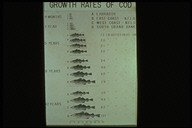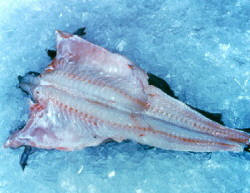
It's a fish-eat-fish world out there in the ocean. Each individual faces enormous odds against it's survival, so each female cod lays millions of eggs. While fishermen are concerned about the movements and abundance of adult fish, many scientists focus their attention on the younger ones. Millions die at each stage of maturity. As long as two grow up to replace each two caught by fishermen, the race goes on. But what determines how many young survive? Scientists know very little about the early life of cod -- perhaps only enough to ask some of the right questions.
Cod spawn on the offshore banks in late winter and spring. Gradually, the eggs float to the surface layer. When they hatch, the tiny larvae live for a week or two on the contents of their yolk sacs. When this is used up, they feed on plankton for several months, then start settling to the bottom. All this time they've been drifting wherever the shifting currents take them. When they finally settle, they may find themselves in a place where life is good, or where it's impossible. The abundance of each new year-class of cod may depend on a roll of the ocean's dice. One species, the cod fish, has been very important to Newfoundland throughout our history. There are about one hundred and fifty different kinds of cod fish. The Atlantic Cod is the largest. It can reach a length of 180 cm (6 ft.) and a weight of over 100 kg (200 lbs.) The cod that fishermen catch, however, are usually much smaller, about 1 kg (2 - 2.5 lb.) The cod has a speckled or spotted pattern on the sides of its body, three dorsal fins, two anal fins, and a small whiskery barbel under the chin.
Like most fish, the cod has special times and places to lay eggs (spawn). The cod is normally a deep water fish but comes into shallower waters to spawn. This usually happens between January and March. Some of the important spawning grounds for cod are found around the Lofoten Islands off the coast of Norway; along the coasts of Greenland and Iceland; and, of course, on Labrador's famous Hamilton Bank and the Grand Bank of Newfoundland. (Banks are shallow, more or less flat ocean areas near the coastline.)
To understand how these conditions affect the numbers of fish, we must study the fish themselves. We must know where and how they live, their place in the food chain, how they grow and develop, their enemies, their reproductive process and their migrations.
An adult female cod lays between 4 and 6 million eggs at a single spawning. The eggs are released into the water to become fertilized. They develop and grow without help from the parents. All but a handful of these millions of eggs will end up as food for other water creatures.
The water temperature plays an important part in the reproductive process. The cod, like most species of fish, have their own favourite temperature range for spawning. If this changes, they may not spawn at all. Also, the eggs and young fish are very sensitive to heat and cold, and temperature changes can kill them.
Cod eggs hatch as they float in the ocean. Of the billions layed, only a small portion survive. Quite a number will drift into water that's too warm or too cold for them to live in. Others drift into water that's too deep. Some wash ashore and dry up. Still others are eaten by birds and other fish.
The surviving eggs float for ten or twenty days until they hatch. Then they are called larval cod and become part of the floating plankton for the next several months. Just as at the egg stage, most of them will die. The larval stage is an even more dangerous one for the cod. The larvae have specks of black that make it easier for their enemies to see them. Also, this stage lasts longer than the egg stage. In addition, they need a steady supply of food and will die if there isn't enough. Those that do survive, drift and grow until midsummer. At this point they are young fish about 2 - 2.5 cm (3/4 - 1 in.) in length.
When the cod are a little older and bigger they move out to deeper water. Eventually they sink to the bottom where they will continue to grow rather quickly. At the end of their first year in the North Atlantic they will be about 15 cm long (6 in.) In two more years they reach a length of about 30 - 45 cm long (12 - 18 in.) At this stage they are called juveniles or tom cods and are already beginning to be caught by fish nets. Young cod that escape the fishing nets and their enemies in the sea, finally grow up fully in their fourth or fifth year. By age six or seven they are ready to spawn for the first time.

We don't often think about cod and their struggle for survival beneath the waves. Yet, these fish are very important to the social and economic well-being of many communities in Newfoundland. Therefore, we need to learn about their home - the ocean. We need to know how to live in harmony with it; how to use it safely; and how to use its resources wisely. Since the discovery of the New World, the Atlantic cod has been the dominant commercial species of the Northwest Atlantic, untill the recent problems it has faced concerning the depletion of the stocks. The cod has traditionally and quite justifiably been called "Newfoundland currency". So important was the cod to the early economy of New England that a carved wooden codfish was hung in the Massachusetts House of Representatives in Boston as a memorial of the importance of the codfish to the welfare of the commonwealth.
The Atlantic cod figured predominantly in the early colonization of North America. The Portuguese began fishing the Newfoundland waters in 1501 and the French and Spanish Basques by the early 1500's. The English fishery was slower to develop in the New World than those of the French, Spanish and Portuguese. When it did, however, it provided a source of training in seamanship that bolstered the British Navy and later contributed to the English supremacy of the seas.
The shipbuilding industry in North America was boosted as the need for fishing ships and cargo ships increased. Consequently, this led to the design of superb crafts with fine, sleek lines of international racing class of which the "Bluenose" of Lunenburg, N.S., was the finest example.
The Atlantic cod (Gadus morhua) is one of 59 species of the family Gadidae. The cod family is the most numerous and best represented of fishes in the Canadian area. A marine fish which occurs mainly in cool waters in northern seas, the cod is soft-rayed, has three dorsal fins on its back and two anal fins behind its whitish-coloured belly, and generally has an elongated hair-like projection called a barbel on its chin. It is generally grey or green but may be brown or reddish, depending upon the habitat into which its colour will generally blend. The scales are small and smooth. The mouth is large with a projecting upper jaw and the gill openings are wide. The lateral line of the cod is pale, and the tail is slightly concave, almost square.
Generally cod average 2 to 3 kg in weight and about 60 to 70 cm in length. They usually do not exceed 30 kg, but there is one record of a cod that weighed about 96 kg and was more than 180 cm long.
![]() click
here to see a net full of cod fish.
click
here to see a net full of cod fish.
A cod's age may be determined by counting the annual rings on the otoliths, two pearly-white earstones that form the balance mechanism in the cod's skull. Atlantic cod grow at different rates in different areas. There are annual differences in growth rate in the same area depending upon population sizes, temperature, and food. Generally, growth is slower off Labrador and eastern Newfoundland than on the southern Grand Banks and is slower in the Gulf of St. Lawrence than on the Scotian Banks and Georges Bank. Most of the cod caught by fishermen in Atlantic Canada are from four to eight years old. Fish older than 15 years are few, although there is a record of a 27-year-old cod taken from Labrador during the 1960's.

Young cod fry feed mainly on copepods, amphipods, and other small crustaceans in the plankton. Juveniles feed mainly on shrimp, amphipods, euphausiids, and fish and shellfish larvae. Adult cod feed mainly on capelin, herring, sand launce, flounders, young Greenland turbot, crabs, shrimp, brittle stars, combjellies, and a host of other species of fish and shellfish. In fact, a cod will eat almost anything including stones so that it can digest the sea anemones, hydroids, and other organisms growing on them.
The female Atlantic cod matures sexually at about six years of age, although the age at first maturity may vary from five to eight, depending on the stock. The size at first maturity generally ranges from about 45 to 60 cm in length. The males generally mature at a slightly younger age and smaller size than the females.
Cod spawning occurs over a wide area of the continental shelf and over a wide range of bottom depths. Cod off Labrador and northern Newfoundland spawn from March to May along the outer slopes of the continental shelf in depths from 200 to 600 m and bottom temperatures of about 2.5 degrees to 4 degrees Celsius. On the Grand Banks, spawning begins in April and continues to June. On the south coast of Newfoundland spawning begins in May. On the Nova Scotia banks, cod spawn in March and April. Occasionally in localized areas cod spawn during autumn.
Cod are very prolific. Female cod about 80 cm long produce about two million eggs, while a cod of about 130 cm produced over 11 million eggs. The eggs are buoyant, round and about 1 to 2 mm in diameter. They float in water of about 30% salinity (coastal surface water). Thus they rise and remain at or near the surface while they are hatching. The fertilized eggs that rise to the surface and the resulting larvae are at the mercy of the currents and face immense hazards from larger predatory fish. The mortality rate is tremendous. Of the several million eggs each female spawns, only about one egg of each million succeeds in completing the cycle to become a mature cod. The newly hatched larvae (about 5 mm long) depend for food on the yolk sac attached to the abdomen for about one to two weeks, after which the yolk is absorbed and the larvae must begin to forage for living food. At about a length of 4 cm, the young cod settle to the bottom and feed there or near the bottom.